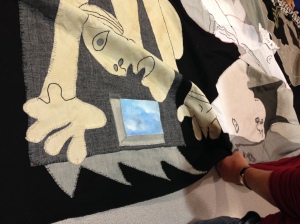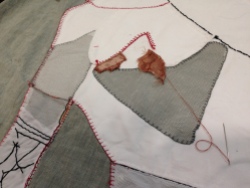 Pallant House Gallery in Chichester offered us two days for public sewings. This welcoming invitation was a perfect opportunity for us to finish the banner, ready to hang in Pallant’s forthcoming Conscience and Conflict Exhibition which opens tomorrow. For these final sewings, we had some highly skilled stitchers among us, who worked confidently and were interested in technique. For most of our public sewings, many of us have been novice stitchers, and we have learnt to observe our own frustrations on occasion, as we struggle to insert a needle through three layers of cloth, or try to work out the best way to attach a slippery or fugitive piece of fabric onto the banner without fraying the edges, for example. At Pallant House, we were frequently captivated by the work being done by hand, as people stood or sat over the cloth, talking together about technique and also about politics – for the banner embodies something you could call the political, or the process of collective resistance to power, by remaking something with hope.
Pallant House Gallery in Chichester offered us two days for public sewings. This welcoming invitation was a perfect opportunity for us to finish the banner, ready to hang in Pallant’s forthcoming Conscience and Conflict Exhibition which opens tomorrow. For these final sewings, we had some highly skilled stitchers among us, who worked confidently and were interested in technique. For most of our public sewings, many of us have been novice stitchers, and we have learnt to observe our own frustrations on occasion, as we struggle to insert a needle through three layers of cloth, or try to work out the best way to attach a slippery or fugitive piece of fabric onto the banner without fraying the edges, for example. At Pallant House, we were frequently captivated by the work being done by hand, as people stood or sat over the cloth, talking together about technique and also about politics – for the banner embodies something you could call the political, or the process of collective resistance to power, by remaking something with hope.
One stitcher spoke to us as she was leaving. She told Megha Rajguru that it wasn’t until much later into her sewing that she’d realised she was working on the Kuffiyeh fabric. She told us that she was raising funds for the Palestine Solidarity Campaign the following Sunday – and apologised for not being there for the Sunday sewing event. She’d started making connections between what she was doing for the Palestinian people, and the meaning of the banner, after she’d recognised the fabric. Another told us of the trip he had taken many years ago, with his students from Christ’s Hospital, along the Camina of the pilgrimage of Santiago da Compostela, threading their way across the summits and valleys of the Pyrenees in the Basque country, as he thought about the Republican resistance to Franco.
Some of the stitchers have been embroidering or stitching for years. Susan Fletcher came with members of the Seffrid Guild, who have been conserving the ancient textiles in Chichester Cathedral, restoring fine work in threads of silk and gold. Susan and the group also create new embroideries for the cathedral, including a set of kneelers for the Lady Chapel. As is usual in the public sewings, people whose skills were more hesitant were soon included in the whole, with kind and generous explanation and practice. Quite a few people told us that Chichester is a Transition Town, one of a network of towns around the country where, for years, people have been collectively working to create a local transition from individualistic, wasteful, fossil-fuel-based economies into those which are gentler, less harmful and more collaborative.
Some of the stitchers belong to the Sew Don’t throw initiative which regularly meets to make things from scraps, recycled and upcycled materials, sharing skills from within the groups which meet. They told us about making bunting for Arundel Artists’ Trail from old parachutes, and dog beds from old fleeces. Nothing is thrown away. People with embroidery skills sewed over the tiny figures of people which months ago we had drawn with a pen onto the body of the dying horse, in order to try to represent the thousands of frequently un-named people killed in aerial bombardments of civilian populations. French knots were used for the heads in some cases, and chain stitch experiments made some of the bodies and limbs. We began to attach the nipples of the striding woman, representative of the resilience, hope and nurturing which is a female version of strength and power. We discussed how we were going to do the final pieces of sewing: strengthening the edges, and creaing a socket or tube along the top edge, so that the banner can be finished and prepared for the exhibition hang.
Among us were stitchers who are volunteer stewards for the gallery, and who belong to Pallant’s Partners in Art Scheme, part of Pallant’s award winning Learning and Community Programme. This scheme partners people with special needs with teams of artists, in order to create and exhibit work, as well as making the work in the galleries accessible and inclusive. We were able to share our different ways of working – some people like to sew from left to right; some from right to left. Some of us like to remain standing while others like to sit and become absorbed in the work before our eyes. Some of us prefer to stitch in light, others in dark, colours. We discussed the process of sewing the centre of the banner, where sometimes we have to climb onto it, or lie across it. The Partners in Arts scheme has generated warmth, and confidence has undoubtedly grown from this, in contexts which the Pallant has provided in order to enable people to develop their practice as artists in relationships with one another.
The sewings took place on Friday 17th and Sunday 19th October. On Saturday 18th, BBC Radio Sussex interviewed collective member Megha Rajguru. On the Sunday, we worked with people who had been moved to come and sew together as a result of having heard the broadcast the day before. As collective member Nicola Ashmore has said: Working collectively, sitting together, cutting, stitching and sticking, has led to a great deal of sharing. A dialogue has unfolded that involves an exchange of individuals’ experiences of sewing; Picasso’s Guernica; activism and current aerial bombardments of civilian populations. Through public sewings like this one, this important dialogue has continued, involving hundreds of people, recorded in the stitches that hold the banner together.
Maude Casey







